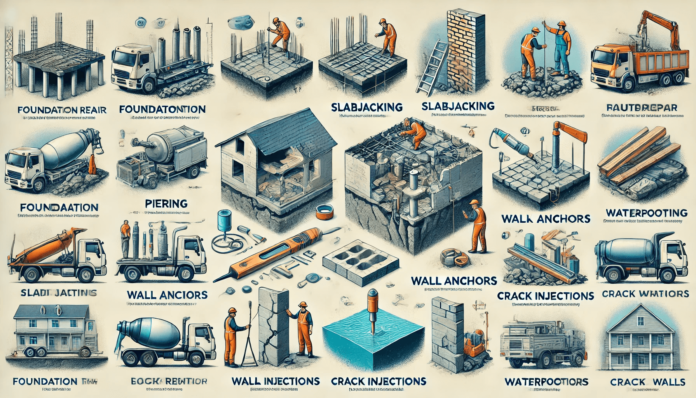Introduction
Understanding foundation repair methods, types of foundation repair, and the latest foundation repair techniques is crucial for maintaining the integrity of any structure. Whether you’re dealing with cracks, settling issues, or water damage, the right repair approach ensures safety and longevity. From underpinning and slab jacking to pier and beam adjustments, there are tailored solutions to address specific foundation problems. This guide explores various methods and types of repairs, detailing when and why each technique is used. Whether for residential or commercial buildings, choosing the appropriate strategy can save time, money, and structural damage in the long run.
Foundation Repair Methods: Comprehensive Solutions for Structural Stability

When it comes to addressing foundation issues, understanding the best foundation repair methods is essential to ensure the long-term safety and stability of your building. Depending on the severity and type of damage, various methods can be employed to repair the foundation effectively.
1. Understanding Foundation Problems
Foundation problems can arise due to several factors, such as soil conditions, poor drainage, and structural stress. Typical signs include:
- Cracks in walls or floors
- Uneven or sloping floors
- Sticking doors and windows
- Water pooling around the foundation
2. Piering and Underpinning
What is Piering?
Piering involves driving steel or concrete piers deep into the ground to stabilize and lift a settling foundation. This method provides long-term support by anchoring the foundation to stable soil layers below.
Types of Piering Methods:
- Steel Piers: Made of galvanized steel, these piers are driven deep into the ground using hydraulic machinery. Steel piers are durable and provide excellent stability.
- Helical Piers: Resembling large screws, these piers are twisted into the soil. They are ideal for lighter structures or areas with limited access.
- Concrete Piers: Large concrete cylinders are pressed into the ground to support the foundation. While cost-effective, they may not be suitable for deeper installations.
When to Use Piering:
Piering is typically recommended for foundations experiencing vertical settling or uneven movement.
3. Slabjacking (Mudjacking)
What is Slabjacking?
Slabjacking is a process where a mixture of cement, sand, and water (or polyurethane foam) is injected beneath a sunken slab to lift it back into place. This method is commonly used for concrete slab foundations.
Steps in Slabjacking:
- Small holes are drilled into the affected slab.
- The mixture is pumped into the holes, filling voids and raising the slab.
- The holes are patched to restore the slab’s appearance.
Benefits of Slabjacking:
- Quick and cost-effective
- Minimal disruption to the surrounding area
- Restores the slab’s original level
When to Use Slabjacking:
This method is ideal for minor settling issues or uneven concrete slabs, such as driveways and sidewalks.
4. Concrete Resurfacing
What is Concrete Resurfacing?
Concrete resurfacing involves applying a thin overlay of cement to damaged concrete surfaces. While not a structural repair, it restores the appearance and smoothness of the foundation.
Steps in Concrete Resurfacing:
- Cleaning and prepping the surface
- Applying a bonding agent
- Spreading a cement-based overlay evenly
5. Wall Anchors
What are Wall Anchors?
Wall anchors are used to stabilize bowing or tilting foundation walls caused by soil pressure. These anchors are installed by attaching plates inside and outside the wall, connected by steel rods.
How Wall Anchors Work:
- Steel rods are inserted through the wall into the soil outside.
- Large metal plates are placed on both sides of the wall.
- The rods are tightened to pull the wall back into alignment gradually.
When to Use Wall Anchors:
This method is ideal for homes with bowing basement walls or retaining walls under pressure.
6. Epoxy and Polyurethane Crack Injections
What are Crack Injections?
Crack injection is a technique used to seal foundation cracks and prevent water intrusion. Epoxy or polyurethane material is injected into the cracks to fill and reinforce them.
Types of Crack Injections:
- Epoxy: Used for structural repairs, as it hardens and strengthens the foundation.
- Polyurethane: Best for sealing active leaks, as it expands and fills the crack entirely.
When to Use Crack Injections:
This method is ideal for small cracks or water leakage issues in basement walls and slabs.
7. Grouting
What is Grouting?
Grouting involves injecting a cement-based mixture into weak or loose soil to improve its strength and stabilize the foundation. This method is often used for buildings in areas with poor soil conditions.
Benefits of Grouting:
- Strengthens surrounding soil
- Prevents further foundation movement
- Works well in conjunction with other repair methods
When to Use Grouting:
Grouting is ideal for areas with highly unstable or expansive soil.
8. Soil Stabilization
What is Soil Stabilization?
Soil stabilization involves treating the soil beneath the foundation with chemicals, lime, or other agents to reduce its movement and prevent future settling.
Methods of Soil Stabilization:
- Chemical Stabilization: Adds chemicals to improve soil cohesion.
- Lime Treatment: Reduces the plasticity of clay soils.
When to Use Soil Stabilization:
This is best for preventing foundation problems in new construction or addressing expansive soil issues.
9. Crawl Space Repairs
What are Crawl Space Repairs?
For homes with crawl spaces, foundation repairs may involve reinforcing support beams, sealing moisture entry points, or installing vapor barriers to prevent water damage.
Common Crawl Space Repairs:
- Installing support jacks to reinforce sagging floors
- Sealing cracks and leaks
- Adding drainage systems to prevent flooding
When to Use Crawl Space Repairs:
This is ideal for homes with sagging floors or moisture-related foundation issues.
10. Waterproofing
What is Foundation Waterproofing?
Waterproofing protects your foundation from water damage by sealing cracks, installing drainage systems, or applying waterproof coatings.
Common Waterproofing Techniques:
- Exterior drainage systems
- Waterproof membranes
- Sump pumps
When to Use Waterproofing:
Waterproofing is a preventive measure or a solution for homes in areas prone to heavy rain or flooding.
Conclusion
Understanding the different types of foundation repair methods is essential for addressing specific issues effectively. From piercing to crack injections and waterproofing, each technique has its advantages and applications. Consulting with a foundation repair professional is crucial to assess the severity of the damage and recommend the best course of action. With the right approach, you can ensure your foundation’s stability and protect your home for years to come.














